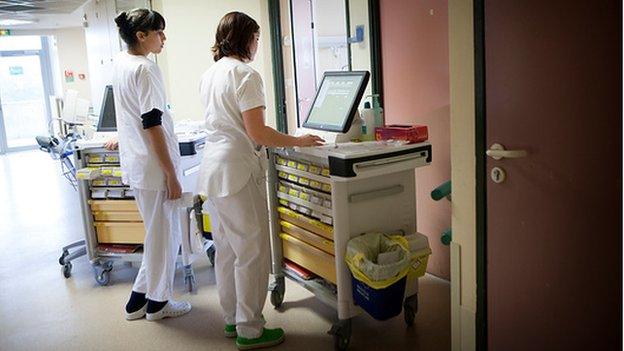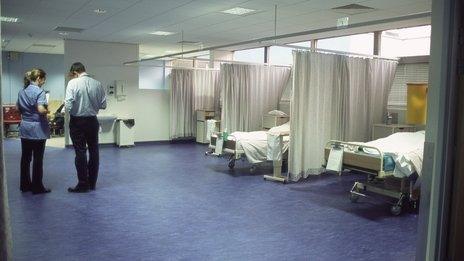How many nurses short is the NHS?
- Published
- comments

Publication of the new guidelines for safe nurse staffing levels on wards marks a key moment for the way hospitals are run.
While the recommendations from the National Institute for Health and Care Excellence do not set an absolute minimum, wards in England are being encouraged not to go above a ratio of one nurse to eight patients.
But the guidance begs the question: just how short of nurses is the NHS? That, unfortunately, is difficult to tell.
At the press briefing on Monday where NICE unveiled the recommendations its officials were repeatedly asked by journalists what the situation was.
During what were, at times, tetchy exchanges NICE was unable to provide a figure.
At one point, Miles Scott, the chief executive of St George's Hospital in London who helped draw up the guidelines, was forced to deny they were trying to "duck" the question.
Neither - when I asked them afterwards - were the Department of Health, NHS England or Health and Social Care Information Centre, the official statistics body for the NHS, able to give an answer. In fact, NHS England and the government questioned the assumption that the NHS was short at all.
Best estimation
In fact, the truth is - despite the NHS being one of the most monitored and audited health systems in the world - we just do not know exactly how many nurses are on the wards.
In his statement praising the new guidelines, Health Secretary Jeremy Hunt did claim there were now 6,200 more nurses working on hospital wards compared to in 2010.
But even that is an approximation as it is based on HSCIC data of nurses working in elderly, general and acute settings - some of these could be working in the community, the HSCIC says. That makes working out how short hospitals are very difficult.
So what would be the best estimation? NICE calculated that the cost of introducing the guidance would be around £200m - this represents about 5% of the total spend on nurses in hospitals.
Does this mean hospitals are short by 5%? NICE refused to acknowledge that. But there is plenty of evidence to suggest the figure may be in the right ballpark.

Hospitals are already monitoring how they are doing on staffing via NHS Choices. This is based on their own calculations of what is needed, so it is not directly comparable to the new guidance.
But as this analysis by the Health Service Journal, external shows there were many trusts missing their targets for the number of hours of nursing care provided. A large number were around 5% short.
Other data also lends support to show this is the true scale of problem. The latest Nurse Supply and Demand Survey, external, which is carried out by NHS Employers and Health Education England, shows about 10% of posts are vacant (but you can expect a number of these will be filled on a day-to-day basis by agency staff).
Meanwhile, the Royal College of Nursing estimates the NHS is short by 20,000 - albeit across the whole health service - which equates to a shortfall of nearly 7%.
Whatever the true figure is - and with the numbers being employed by the NHS going up and down all the time - it is likely to be a fluid situation, the question of just how short hospitals are is one that is going to be grappled with on a regular basis from now on.